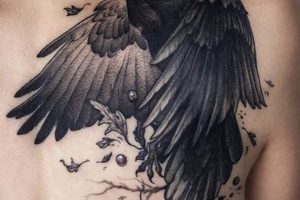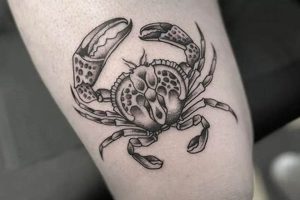Representations of Aztec culture rendered in body art offer a rich tapestry of imagery drawn from mythology, cosmology, and daily life. Common motifs include deities such as Quetzalcoatl and Huitzilopochtli, animals like jaguars and eagles, calendrical symbols, and intricate geometric patterns. These designs can be executed in various styles, from traditional blackwork to vibrant color schemes.
These visual expressions serve as powerful statements of cultural heritage and personal identity. They can represent a connection to ancestral roots, an appreciation for artistic tradition, or a fascination with pre-Columbian history. The enduring appeal of this art form stems from the intricate artistry and symbolic depth of the source material, offering a meaningful way to connect with a rich cultural legacy.
Further exploration of this subject will delve into specific design elements, their historical significance, and considerations for choosing and designing meaningful body art inspired by the Aztec civilization.
1. Symbolism
Symbolism forms the core of Aztec art and, consequently, holds immense importance in Aztec-inspired tattoos. Every element within these designs carries weight, communicating complex narratives drawn from mythology, cosmology, and daily life. For instance, the image of an eagle represents not merely the animal itself, but also concepts of strength, courage, and connection to the heavens. Similarly, the serpent, often depicted with feathers (Quetzalcoatl), embodies knowledge, duality, and the cycle of life and death. The choice of specific symbols imbues the tattoo with personal meaning, reflecting the wearer’s values, beliefs, or aspirations.
Understanding the historical and cultural context of these symbols is crucial for creating a respectful and authentic tattoo. A seemingly simple geometric pattern can hold deep cosmological significance, representing the intricate workings of the universe as perceived by the Aztecs. For example, the use of specific colors held symbolic weight: green often represented vegetation and growth, while blue could symbolize water or sacrifice. Appreciating the cultural weight behind these elements ensures that the chosen design is not just aesthetically pleasing but also carries the intended symbolic resonance.
Ultimately, the power of Aztec tattoo designs lies in their rich symbolic language. Careful research and consideration of these symbols are essential for creating a meaningful and impactful piece of body art. Ignoring the historical context risks misrepresenting a complex culture and diminishing the inherent power of its artistic expressions. Choosing a design based on genuine understanding and respect for its symbolism ensures the creation of a tattoo that resonates with both personal significance and cultural integrity.
2. Deities
Aztec deities played a central role in their cosmology and daily life, offering a rich source of inspiration for tattoo designs. Representing these deities in body art serves as a powerful connection to this ancient culture, embodying specific attributes and beliefs.
- Quetzalcoatl
The feathered serpent deity represents knowledge, duality, and the cycle of life and death. Often depicted with vibrant plumage and serpentine coils, Quetzalcoatl tattoos can symbolize transformation, learning, and balance. Variations may emphasize different aspects, such as its connection to Venus as the morning star.
- Huitzilopochtli
The god of war, sun, and human sacrifice, Huitzilopochtli, appears in tattoos as a fearsome warrior adorned with hummingbird feathers. Representations often include weaponry and symbolic colors, associating the wearer with strength, courage, and sacrifice. Designs can highlight his role as a protector and tribal deity.
- Mictlantecuhtli
The skeletal lord of the underworld, Mictlantecuhtli, represents death, decay, and the journey of the soul. Tattoos featuring this deity often incorporate skeletal imagery, owls, and symbols of the underworld. These designs can symbolize acceptance of mortality, respect for ancestors, and the cyclical nature of existence.
- Coatlicue
The earth goddess, Coatlicue, embodies creation, fertility, and the duality of life and death. Often depicted with a severed head and skirt of serpents, she represents the constant cycle of renewal. Tattoos featuring Coatlicue symbolize connection to nature, feminine power, and the acceptance of both creation and destruction.
The choice of deity reflects the wearer’s personal connection to specific aspects of Aztec spirituality and worldview. These potent symbols offer a profound way to express identity and belief through the medium of body art, perpetuating the legacy of these powerful figures.
3. Animals
The Aztec worldview revered the animal kingdom, attributing symbolic meanings to various creatures. These animals, often associated with deities or natural forces, became potent symbols integrated into art, rituals, and personal adornment. In the context of tattoos, animal depictions serve as powerful expressions of specific qualities, beliefs, and connections to the natural world.
- Jaguar
Representing strength, power, and the warrior spirit, the jaguar held a prominent position in Aztec culture. Often associated with Tezcatlipoca, the god of night and sorcery, jaguar imagery in tattoos can symbolize courage, ferocity, and connection to the spiritual realm. Depictions range from realistic portrayals to stylized jaguar pelts, emphasizing different aspects of the animal’s symbolic power.
- Eagle
Symbolizing the sun, sky, and spiritual ascension, the eagle represented power, vision, and connection to the divine. Associated with Huitzilopochtli, the god of war and sun, eagle tattoos embody courage, freedom, and the pursuit of higher ideals. Depictions often include outstretched wings, talons grasping prey, or connections to solar imagery.
- Serpent
Representing transformation, knowledge, and the cyclical nature of life and death, the serpent holds a complex role in Aztec symbolism. Often depicted with feathers as Quetzalcoatl, the feathered serpent deity, serpent tattoos can symbolize wisdom, healing, and the continuous cycle of renewal. Variations can highlight the serpent’s connection to the earth, water, or the cosmos.
- Hummingbird
Associated with Huitzilopochtli, the hummingbird symbolized agility, skill, and resilience. In tattoo designs, hummingbirds represent energy, joy, and adaptability. Their vibrant colors and delicate forms often complement floral motifs, creating visually striking and symbolically rich compositions.
The choice of animal reflects the wearer’s personal resonance with specific attributes and beliefs. By incorporating these powerful animal symbols into tattoo designs, individuals connect with a rich cultural heritage and express their unique identity through the lens of the Aztec worldview.
4. Calendar Designs
Aztec calendar systems, complex and deeply intertwined with their cosmology and daily life, provide a rich source of inspiration for tattoo designs. These intricate systems, notably the xiuhpohualli (365-day solar calendar) and the tonalpohualli (260-day sacred calendar), weren’t merely time-keeping devices; they reflected a profound understanding of cyclical time, cosmic events, and the interplay of divine forces. Incorporating calendar designs into tattoos offers a powerful way to connect with this intricate worldview and express a fascination with Aztec cosmology. The most recognizable example, the Aztec Sun Stone (often mistakenly referred to as the Aztec Calendar), depicts Tonatiuh, the sun god, at its center, surrounded by glyphs representing days, months, and cosmological cycles. This iconic image, frequently chosen for its visual impact and symbolic weight, represents the cyclical nature of time, the power of the sun, and the interconnectedness of the cosmos.
Beyond the Sun Stone, other calendar elements, such as individual day signs and glyphs representing specific deities or events, can be incorporated into tattoo designs. For example, a person born on a day associated with the jaguar might choose to incorporate the jaguar glyph into a calendar-themed tattoo, linking their personal identity to the Aztec system of beliefs. Additionally, the intricate geometric patterns and numerical systems inherent in the calendars themselves offer visually compelling design elements, allowing for highly personalized and aesthetically striking tattoos. These designs can be rendered in various styles, from traditional blackwork emphasizing the glyphs’ intricate details to more contemporary interpretations incorporating color and other visual elements.
Choosing a calendar-based design requires careful consideration of its symbolic meaning and cultural context. Understanding the specific significance of the chosen glyphs, numbers, or cyclical representations ensures that the resulting tattoo carries the intended meaning and respects the cultural heritage it draws upon. By delving into the rich symbolism of Aztec calendars, individuals can create tattoos that not only serve as striking visual statements but also reflect a deep appreciation for a complex and fascinating culture.
5. Geometric Patterns
Geometric patterns form an integral component of Aztec art and, consequently, hold significant weight in Aztec-inspired tattoo designs. These patterns, far from mere aesthetic embellishments, often carry deep symbolic meaning, representing cosmological concepts, natural forces, or specific deities. The intricate interplay of lines, shapes, and angles creates visually compelling designs while simultaneously communicating complex narratives drawn from the Aztec worldview. For instance, repeating step patterns might symbolize mountains, representing stability and connection to the earth, while spiral motifs could evoke the cyclical nature of time and the continuous flow of energy. The skilled integration of these patterns within larger tattoo designs adds depth and cultural significance.
The use of specific geometric patterns within Aztec tattoos often relates directly to the other design elements incorporated. For example, a tattoo featuring Quetzalcoatl, the feathered serpent deity, might incorporate repeating diamond patterns, symbolizing the serpent’s scales and its connection to the earth and sky. Similarly, a tattoo depicting the Sun Stone might utilize concentric circles and radiating lines to evoke the sun’s power and the cyclical nature of time. This interplay of geometric patterns and representational imagery creates a cohesive and symbolically rich design, enhancing the overall impact and meaning of the tattoo. Furthermore, the precision and complexity of these patterns showcase the artistic skill involved in both their creation and execution as tattoos.
Understanding the symbolic meaning inherent in Aztec geometric patterns is crucial for creating a respectful and authentic tattoo. Choosing patterns based solely on aesthetics risks misrepresenting a complex culture and diminishing the power of its artistic expressions. Careful consideration of the chosen patterns and their interplay with other design elements ensures the creation of a tattoo that resonates with both personal significance and cultural integrity. This approach allows individuals to connect with the rich artistic legacy of the Aztec civilization while expressing their own unique narratives through the powerful medium of body art.
Tips for Choosing Aztec Tattoo Designs
Careful planning ensures a meaningful and culturally respectful tattoo. Consider these points before committing to a design.
Tip 1: Research Thoroughly
Understanding the historical and cultural significance of chosen elements is paramount. Avoid appropriating imagery without grasping its meaning. Consult reputable sources and consider engaging with experts or individuals with cultural ties to the Aztec civilization.
Tip 2: Choose a Reputable Artist
Seek an artist experienced in executing intricate designs and familiar with the cultural nuances of Aztec art. Review portfolios for examples of previous work in similar styles. Discuss design ideas thoroughly with the chosen artist to ensure a shared understanding of the desired outcome.
Tip 3: Consider Placement and Size
The size and complexity of the design should complement the chosen body placement. Intricate designs require sufficient space for proper execution. Consider the visibility and personal significance of different body areas when deciding on placement.
Tip 4: Reflect on Personal Meaning
A tattoo serves as a permanent form of self-expression. Choose elements that resonate personally and reflect individual values or beliefs. Connect the chosen design to a personal narrative or experience to enhance its meaning.
Tip 5: Plan for Long-Term Care
Tattoos require ongoing care to maintain their vibrancy and prevent fading. Follow the artist’s aftercare instructions diligently. Protect the tattoo from excessive sun exposure and consider touch-ups as needed to preserve its integrity over time.
Careful consideration of these factors ensures a tattoo that serves as a powerful and meaningful expression of personal identity and cultural appreciation.
By following these guidelines, individuals can embark on the journey of acquiring an Aztec-inspired tattoo with confidence and respect, creating a lasting tribute to a rich and complex civilization.
Frequently Asked Questions about Aztec Tattoo Designs
This section addresses common inquiries regarding Aztec-inspired tattoos, offering clarity and guidance for those considering such designs.
Question 1: Are Aztec tattoos culturally appropriative?
Appropriation becomes a concern when designs are chosen without understanding or respect for their cultural context. Thorough research and genuine appreciation mitigate this risk. Consulting with individuals of Aztec descent can offer valuable insights.
Question 2: How painful are Aztec tattoos?
Pain levels vary based on individual tolerance, placement, and design complexity. Generally, areas with thinner skin or closer proximity to bone experience greater sensitivity. Discuss pain management options with the chosen tattoo artist.
Question 3: How much do Aztec tattoos typically cost?
Cost depends on factors like size, complexity, artist’s experience, and geographic location. Intricate designs requiring multiple sessions will naturally incur higher costs. Consult with several artists to obtain quotes and compare pricing.
Question 4: How long do Aztec tattoos take to heal?
Healing typically takes 2-4 weeks, depending on individual factors and tattoo size. Proper aftercare is crucial for optimal healing and color retention. Follow the artist’s instructions diligently to minimize complications.
Question 5: Can Aztec tattoos be covered up or removed?
Cover-ups and removals are possible but present challenges due to the often intricate and bold nature of Aztec designs. Laser removal is the most effective method, but multiple sessions may be required. Consult with a specialist to discuss options.
Question 6: What are some common design elements in Aztec tattoos?
Common elements include deities (Quetzalcoatl, Huitzilopochtli), animals (jaguars, eagles), calendar symbols, and geometric patterns. Each element carries specific symbolic meaning, contributing to the overall narrative of the tattoo.
Thorough research and thoughtful consideration are essential for choosing a meaningful and culturally respectful Aztec-inspired tattoo.
Further exploration of specific design elements and consultations with experienced tattoo artists will aid in making informed decisions.
Aztec Tattoo Ideas
Exploration of Aztec tattoo ideas reveals a rich tapestry of symbolic imagery drawn from a complex and fascinating culture. From powerful deities like Quetzalcoatl and Huitzilopochtli to symbolic animals such as jaguars and eagles, the intricate designs offer profound avenues for personal expression and cultural appreciation. Geometric patterns and calendar systems further enrich the visual and symbolic landscape, adding layers of meaning to these powerful forms of body art. Careful consideration of these elements, combined with thorough research and collaboration with skilled artists, is essential for creating tattoos that resonate with both personal significance and cultural integrity.
The enduring appeal of Aztec-inspired tattoos lies in their ability to connect individuals with a vibrant historical legacy. These designs serve as more than mere aesthetic adornments; they represent a powerful form of storytelling, allowing wearers to embody specific values, beliefs, and connections to the past. The journey of exploring and choosing an Aztec tattoo should be approached with respect, understanding, and a deep appreciation for the cultural heritage it represents. This thoughtful approach ensures that these powerful symbols continue to resonate with meaning and purpose for generations to come.







